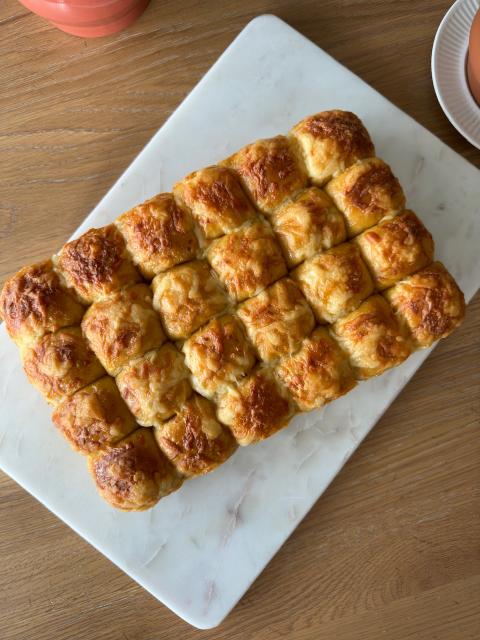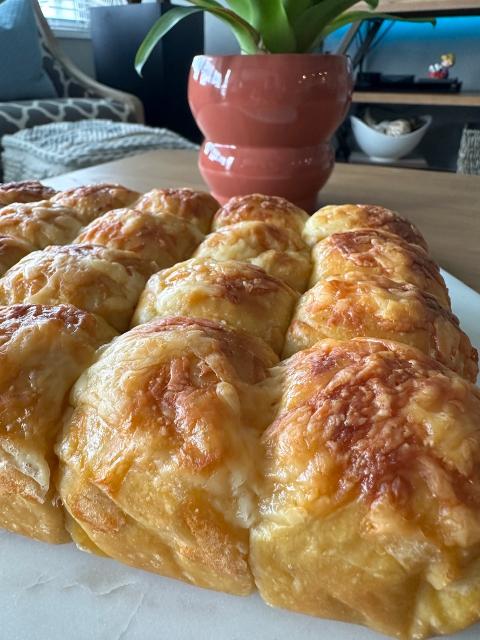
Miso Sweet Potato Cheddar Sourdough Milk Rollls
We are still enjoying our extended visit here in Fort Lauderdale where we are seeing friends that we don’t otherwise. Since many of them know that I like baking bread, I am getting requests to bring bread to their dinner parties in lieu of bringing the usual bottle of wine. So for this dinner party I decided to bring milk rolls since they alway seem to go over well, but decided to try using my homemade red miso to amp up the flavour of the sweet potato and butter along with the cheddar cheese on top of the rolls. As I may have written about in the past, the amount of miso needed to really be a prominent flavour in a bread would probably make it too salty. However, miso is rich in glutamate, an amino acid that is released as the Aspergillus oryzae’s proteinases bread down the proteins in the soybeans as the miso is fermenting. Glutamate is one of the substances that give food umami, that fifth taste sensation. So it really brings out the other flavours in the food.
Our host for the evening only heated up half of the two dozen rolls saying that he was being selfish and keeping the other dozen for himself since they were so delicious. So I guess they went over well.
I am without my trusty Ankarsrum Assistent down here so I am developing all my doughs by hand. For these enriched doughs it is a lot of slap and folds, but I am getting a bit of exercise from it.
24 rolls in a 7.5 x 11.5” pan
egg wash: 1 yolk and 1 tbsp milk, beaten…
Prepare the stiff sweet levain overnight or the day before and refrigerate when ready.
Prepare the butter paste by blending very soft butter with flour. Doing this makes the butter faster to incorporate by hand than adding the butter directly in my experience. I don’t do this if I am using my Ankarsrum Assistent.
Cook Tangzhong mixing flour and milk constantly until it becomes a thick roux. Let cool before adding to final dough. Or add to cold milk and egg to cool it down. Add the levain and break it up into small pieces with your spatula. Add and dissolved miso paste and salt.
To mix by hand, add the flour to the wet ingredients (milk, tangzhong and egg) to dissolve. Next add the flour and mix with a silicone spatula until no dry flour remains. Rest 10-20 mins. Next perform French folds until the dough is well developed. Smear the butter onto the dough and then fold to incorporate and then perform further French folds until well developed. Gradually add the mashed potato and knead to incorporate it well into the dough. Form into a tight ball and place in a bowl covered with plastic or a damp cloth @ 82°F for 3-4 hours, some rise will be visible. Alternatively, you could mix the mashed potato and butter and then add the mixture to the developed dough until well incorporated.
Butter a large baking pan or line the pan with parchment. Punch the dough down and then divide into 24 equal portions. Form each into tight boules. Place in the buttered baking pan seam side down. Cover them and allow them to fully proof about 4-6 hours, they should pass the poke test.
About 30 mins before the end of proofing time, whisk your remaining egg and milk and then brush the small boules.
About 30 mins prior to end of final proof preheat the oven to 350°F.
Immediately prior to baking brush the dough again with the egg and milk mixture. Top with the shredded cheddar cheese to your preference.
Bake the rolls uncovered for 30-35 minutes or until the internal temperature is at least 190F. Cover if your rolls get brown early in the baking process.
Remove the bread from the oven but not the pans, brush the tops with the melted butter while hot, and then let cool for 10 minutes before pulling the bread from the pans. You may need to slide a butter knife down the sides of the pan to loosen the bread, but I have found parchment paper to be unnecessary.








Comments
These look and sound amazing. I can understand why your friend wanted to save half for themselves.
I am a big fan of melting cheese on top of rolls and yours look perfect.
Best,
Ian
Thank you Ian. Strangely I have rarely, maybe once that I can remember, put cheese on top of my bread, pizza of course but bread, rarely. I think I prefer cheese on top to cheese inside, since most cheeses will melt and leave a void in the crumb which I don’t like seeing, feta being an exception.
Benny